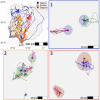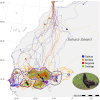Early life movements and mortality of Egyptian vultures: Implications for transcontinental conservation
- PMID: 39279788
- PMCID: PMC11402506
- DOI: 10.1002/ece3.70291
Early life movements and mortality of Egyptian vultures: Implications for transcontinental conservation
Abstract
Understanding the movements and mortality of individuals across different life stages is crucial for the effective conservation of wild populations. We used data from 32 Egyptian vultures (Neophron percnopterus) tagged with GPS transmitters as nestlings in three Iberian breeding areas to study their dependence period, migration routes, movements in Africa, and mortality at each stage. Our results show no significant differences in the timing of nest departure or the duration of the dependence period between individuals of different sexes or breeding nuclei. Most juveniles migrated to sub-Saharan Africa in their first year, but some (3 of 32, 9.4%) remained in the Iberian Peninsula. Individuals that migrated to Africa did so annually, while those remaining in Iberia never migrated to the Sahel, indicating distinct migratory and non-migratory strategies. Non-migratory individuals consistently moved northward during the breeding season to their natal territories. Siblings did not coordinate their migration strategy or timing. All juveniles showed extensive overlap in the vast areas used in Africa, where females arrived before males, and in the Iberian Peninsula. Our study also revealed that no juveniles died immediately after fledging, but that none of the tagged individuals lived more than 7 years or were recruited as breeders. Although most casualties occurred during the longer stay in the Sahel, the mortality rate was highest during the few days of the first migration. Our results show that despite small variations in movement patterns between breeding nuclei and sexes, Egyptian vultures face similar challenges during the years before recruitment as breeders, mostly determined by their migratory strategy. These findings are relevant for designing conservation strategies, both in breeding areas and, more importantly, in wintering areas and along migration pathways. Such strategies will significantly impact the entire Iberian population of this endangered species.
Keywords: Egyptian vulture; Iberian Peninsula; Sahel; dependence period; migration; mortality.
© 2024 The Author(s). Ecology and Evolution published by John Wiley & Sons Ltd.
Conflict of interest statement
We declare that we have no competing interests.
Figures




References
-
- Arrondo, E. , Moleón, M. , Cortés‐Avizanda, A. , Jiménez, J. , Beja, P. , Sánchez‐Zapata, J. A. , & Donázar, J. A. (2018). Invisible barriers: Differential sanitary regulations constrain vulture movements across country borders. Biological Conservation, 219, 46–52. 10.1016/j.biocon.2017.12.039 - DOI
-
- Arrondo, E. , Sanz‐Aguilar, A. , Pérez‐García, J. M. , Cortés‐Avizanda, A. , Sánchez‐Zapata, J. A. , & Donázar, J. A. (2020). Landscape anthropization shapes the survival of a top avian scavenger. Biodiversity and Conservation, 29, 1411–1425. 10.1007/s10531-020-01942-6 - DOI
-
- BirdLife International . (2021). Neophron percnopterus (Europe assessment). The IUCN Red List of Threatened Species 2021: e.T22695180A166295484. 10.2305/IUCN.UK.2021-3.RLTS.T22695180A166295484.en - DOI
-
- Blanco, G. (2014). Can livestock carrion availability influence diet of wintering red kites? Implications of sanitary policies in ecosystem services and conservation. Population Ecology, 56, 593–604. 10.1007/s10144-014-0445-2 - DOI
LinkOut - more resources
Full Text Sources

